Whether you’re interested in betta breeding (Betta splendens) for fun or as a potentially profitable hobby, there’s a few things to consider before you get started.
While these colorful fish are ideal for first-time and novice aquarists, mating them is trickier than just maintaining a pet, so let’s talk about how to breed betta fish!
Should You Start Breeding Bettas?
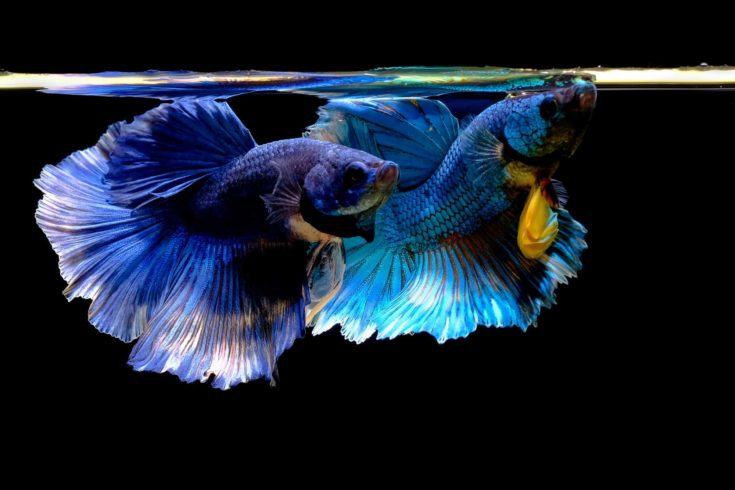
Betta fish aren’t the easiest species to breed even though they make great pets. Small mistakes that wouldn’t hurt an adult fish may spell doom for mating or tank of delicate, newly-hatched betta fry. Breeding is an exhausting process for the adults, and takes a month of preparation, so it’s best left to aquarists who are:
- Familiar and comfortable with the process of setting up and cycling new betta aquariums and using testing kits to track the pH, ammonia, nitrites, nitrates and general hardness of the water in their tanks.
- Have experience caring for several aquariums at the same time, particularly with feeding live foods, Nitrogen Cycle and water quality monitoring, aquarium maintenance and record-keeping.
- Have the physical space and financial means to set up and maintain several habitats, since at the very least you’ll need a tank for your male, a separate tank for your female or sorority group, and a special breeding tank set-up for the actual mating process and hatching fry.
Overview Of Betta Mating Behavior
Bettas are a bit challenging to breed because they’re solitary animals who don’t live in mixed-gender groups in the wild. That makes it harder for betta breeders to replicate their natural conditions in captivity than for fish like guppies or freshwater snails:
- Wild male and female bettas only come together for any length of time to mate, and female fish leave the area immediately after.
- Female bettas actively avoid male fish except when they’re conditioned for breeding (gravid) and thus “receptive” to the male’s aggressive advances.
- If you just dump a pair of bettas in a tank and leave them to get on with their business, you’ll end up with no babies, a dead female betta and might even lose your male fish.
How Do Betta Fish Reproduce?
Before we can dive into the details on choosing and conditioning your adult bettas for breeding, let’s cover the highlights of the process. If you’ve ever wondered how betta fish get pregnant, the answer is they don’t. In fact, bettas don’t even have sex! So how do bettas mate, then?
- Bettas reproduce sexually, meaning they have two distinct genders and each parent contributes 50% of their genetic material to their offspring (ironically, sexual reproduction does not require animals to have sexual intercourse).
- Bettas are a spawning species of fish; female bettas lay eggs and the males fertilize them in the water afterward. Since the eggs are fertilized outside of her body, female bettas don’t store sperm and can’t reproduce without fresh contact with a fertile male.
- Male bettas build bubble nests to entice female fish to spawn with them, and they provide care to the developing embryos until shortly after they’ve hatched.
- Once the fry are free-swimming, though, there’s a risk that the male may consume them, which is why you can’t breed your bettas in the male’s home aquarium, and should use a breeding tank instead.
What Does It Mean To Condition A Betta For Breeding?
Conditioning your adult bettas prepares them for the mating process in several ways, and it involves both dietary and environmental shifts in their habitats. Basically, you’re mimicking the conditions experienced by wild betta fish during their natural breeding season. When is mating season for betta fish?
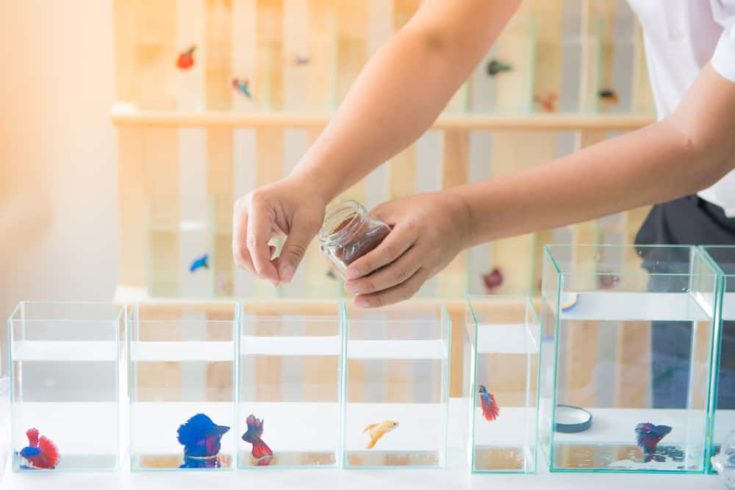
It depends on where the population is located, but it usually starts in the spring and runs through the early summer months in Thailand. Feeding your adults a protein-rich diet of live foods like brine shrimp and bloodworms mimics their natural conditioning and enhances your adult betta’s health and appearance.
Conditioning isn’t limited to dietary changes, though. Wild bettas rely on other environmental clues to signal it’s the right time to mate, so you may need to adjust the water chemistry and/or your maintenance routines to mimic these seasonal conditions in your betta aquariums:
- Conditioning and breeding tanks should remain free from ammonia, nitrites or nitrates, so test your water several times a week and change the water as needed to keep these toxins at undetectable levels.
- While pet bettas tolerate water with a general hardness (GH) from 4 to 20 degrees (d), for breeding they prefer softer water that measures 4 to 8 dGH with a testing kit.
- Conditioning and breeding tanks should have slightly acidic water at a temperature of 80°F, and ideally, a pH that measures right around 6.5.
- Floating an Indian almond leaf from the Terminalia catappa tree in your betta tank can naturally soften the water and slightly lower the pH. They’re widely available in aquatic shops and online, and are commonly used in aquariums and breeding set-ups.
Equipment, Supplies And Set-Ups For Breeding Bettas
Now that you understand the importance of conditioning your adult bettas prior to breeding and the ideal parameters for their aquariums and breeding set-up, let’s take a look at the equipment and supplies you’ll need to get the process started!
To breed bettas, you’ll need:
- Two fully equipped and cycled tanks for the adult fish.
- At least one conditioned male and female betta fish for breeding.
- A bare 10-gallon aquarium with a glass cover, heater, temperature gauge and sponge filter for your breeding tank.
- Water testing kit for pH, GH, ammonia, nitrite and nitrate.
- Java moss, Indian almond leaves, plastic wrap and a styrofoam cup.
- Tall (6-inch+) glass jar or vase, or a divider for your breeding tank.
- Bucket and a siphon with hose or tubing for water changes and maintenance.
- Fresh and/or frozen foods like brine shrimp, bloodworms and Daphnia eggs.
How To Choose Your Breeding Pair Of Betta Fish
What should you look for when shopping for a pair of bettas to breed? Their age is actually one of the most important factors:
- You’ll want to select bettas that are from 4 to 11 months old, since fertility drops off dramatically after their first year.
- It’s not worth the time and effort to condition bettas older than 12 months, since there’s little chance they’ll successfully reproduce.
You’ll also want to choose fish that have the characteristics you’re interested in. If you want to produce Double-Moon bettas, you’ll need to pick adults that have or carry that trait. Color can be a lot more complicated, so I recommend you learn about the genetics of betta coloration and work with experienced betta breeders.
You might also make hybrid fish by cross-breeding Betta splendens with a wild species like the Betta plakat. Since wild-type bettas are often more aggressive than the fancy splendens, it can be harder to manage their mating behaviors, so this isn’t an ideal choice for your first mating.
How To Pick the Best Male And Female Betta For Breeding
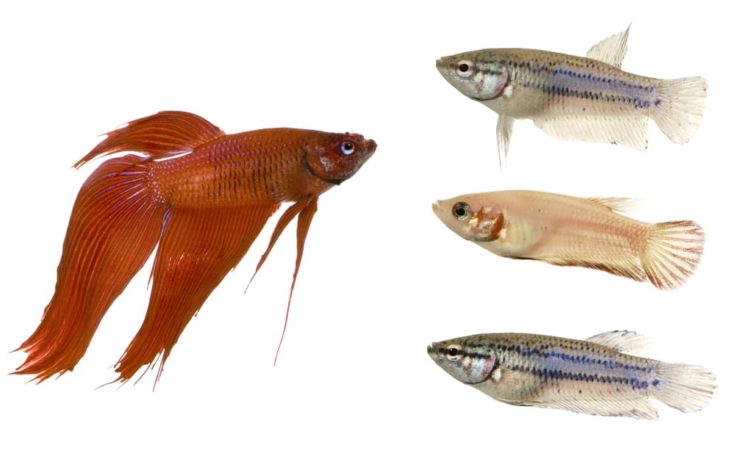
When you’re comparing betta fish as you shop for your breeding stock, how can you identify the best male or female out of a group? Examine each betta in the shop and compare their energy level, coloration and overall body condition.
Choose Energetic And Active Bettas
Look for fish that are very active, bright and energetic! They should be curious, responsive to their environment and have a great appetite. Avoid buying bettas that look listless, dull or show little interest in food. Don’t buy poorly conditioned bettas or from a shop that keeps them in tiny cups or dirty aquariums.
Look For The Brightest, Most Colorful Male Betta
While you’ll be conditioning your bettas further prior to mating, it’s still important to pick the best-looking breeding male you can find. In the wild, the female betta is in charge of the mating process and selects her ideal mate, so you’ll need to pick a male that’s very appealing to the ladies!
- Male fish with a deep, rich color are more likely to be healthy and free from parasites than pale-colored fish.
- Female bettas are naturally less colorful and more muted than the boys, so focus on choosing ladies for their energy level and overall condition rather than their colors.
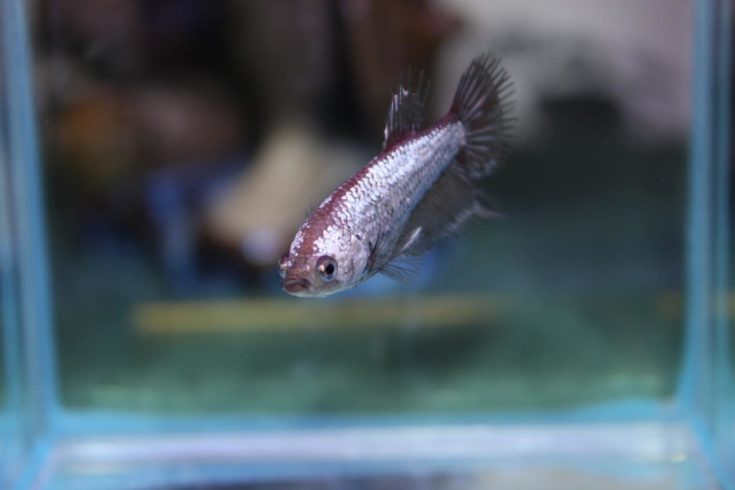
Female bettas definitely prefer male fish with rich, jewel-like tones over pale or lighter shades. Similar to other species like the guppy that are driven by female preferences for brightly-colored males, there’s some evidence that female bettas prefer males with the red/orange pigment more than any other color.
Size, Body And Fin Condition
The male and female bettas you pick should have perfect body conditioning, with no missing scales or patches of fungus to be seen. They should be plump but not obese, and their fins should be smooth and free from any jagged edges or injuries. Healthy bettas heal quickly, so damaged fins could be a sign of a sick fish.
It’s best to match your breeding bettas for size, so choose a female that’s just slightly smaller than your male betta. Avoid choosing a female that’s larger than your male, though, since that type of pairing usually fails.
Where To Buy Your Breeding Stock
The best place to find breeding stock is to look for experienced local breeders and buy fish directly from them. This is an ideal situation, since the breeder will know the exact age and lineage of their fish, and can help you plan a good pairing.

Don’t waste your time or money buying generic pet store bettas for breeding. While these fish are fine as pets, they’re rarely of the age or quality necessary for breeding. Many pet stores don’t care for their bettas properly, so you may not be able to successfully condition or breed these fish anyway.
How To Condition Adult Bettas For Breeding
After allowing your breeding bettas to settle into their new tanks for a week, it’s time to start conditioning them! It usually takes between 2 and 4 weeks to get your bettas in shape and ready to mate.
Frequent Water Changes And Testing
During the conditioning process, you’ll want to closely monitor the chemistry in your betta’s tanks as discussed above, but you’ll also want to do at least two 25% water changes every week even if the toxin levels are undetectable. This mimics the seasonal rainy conditions experienced by wild bettas.
Breeding Betta Conditioning Diet
It’s best to feed your bettas 3 to 4 times a day while you’re conditioning them, but give them less food per meal so they don’t eat too much. Offer about as much food as they can consume in a minute and aim to feed them every 6 to 8 hours. It’s best not to fast fish when conditioning them, so feed them 7 days a week:
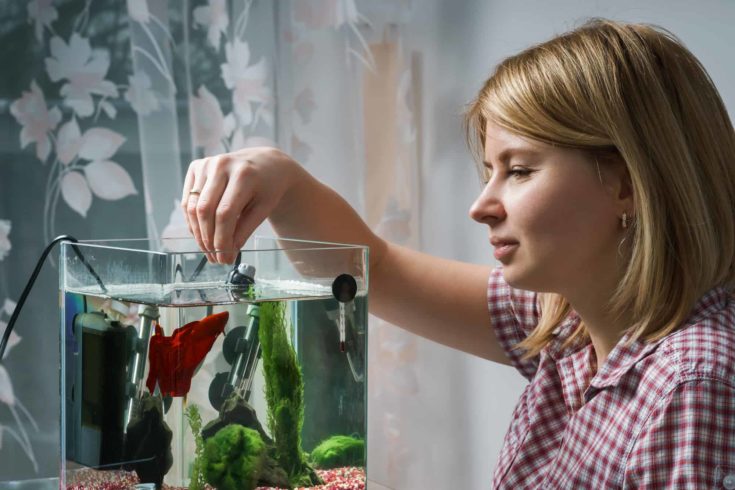
- Offer one meal a day of a high-quality omnivore floating flake or pellet diet.
- Feed three high-protein and preferably live or frozen meals a day, rotating in a selection of foods including brine shrimp, tubifex or bloodworms, Daphnia and shrimp eggs, mosquito and insect larvae.
How Do You Know When Your Betta Fish Are Ready To Mate?
There’s no hard-and-fast rules to knowing when your bettas have been conditioned enough and are ready to mate, since the most noticeable signs won’t be obvious until the fish actually interact with each other in the breeding tank. When your male sees a female or rival betta:
- If he’s ready to mate, your male should turn a deeper color and flash his fins at them, and may try to chase or attack the other fish.
Some females are shyer at first, and may clamp their fins tightly against their body, but she’ll often warm up to the male betta once she’s watching him in the breeding tank:
- The most obvious sign of a receptive or gravid (egg-filled) female is the white dot that appears by her ovipositor tube, located behind her ventral fin. You should be able to see this dot while she’s in her home tank, but it will become clearer once she’s in the breeding tank.
- A receptive female’s color will also darken when she sees a potential mate, and she’ll develop vertical bars or stripes on her abdomen. If the bars run horizontally, though, that’s a sign she’s not ready to breed.
How To Set-Up Your Breeding Tank
Breeding tanks are very simple aquariums without any substrate and usually nothing more than a sponge filter or air stone and some floating plants like Java Moss for the female betta and fry to hide in. Since betta fry are small and can’t swim very well, never fill the water in a breeding tank deeper than 5-inches:
- Avoid using substrate in a breeding tank, because it’s harder for your male to see the eggs if they fall out of the bubble nest and makes it more difficult to care for the hatched fry.
- Avoid using powerful HOB or internal filters because they create too much current and may hurt the eggs and delicate fry.
- Be sure to baffle the outflow of your sponge filter so there’s no current in the tank and the water is mostly still.
While you don’t have to use a filter in a breeding tank, I’ve found that the tip of a sponge filter is an ideal home for good bacteria, as long as you’re careful in how you maintain it. Always rinse your breeding or fry sponge filters in a bucket of conditioned water, or even better, some water from a healthy betta tank, rather than using tap water (which could kill off the good bacteria).
Breeding Tank Set-Up Step-By-Step
- Place your bare, 10-gallon aquarium on a sturdy, aquarium-safe table or shelf in a quiet location away from bright lights.
- Fill with 3 to 5 inches of conditioned water (or toxin-free water from another healthy betta tank to help jump-start the cycling process).
- Add an aquarium heater to the tank, tilting the tube to fully submerge the unit, and set the temperature to 80°F.
- Add a temperature gauge or sticker to the tank, ensuring the gauge is placed below the waterline.
- Arrange your sponge filter and baffle in the tank, or set-up your air stone, and connect it to the air pump with plastic tubing.
- Check over your equipment, and if it all looks good plug in the heater and air pump. Allow your heater and filter to run for 24 hours, and then check and adjust the flow and temperature until they’re in the ideal range.
- Add some floating plants like Java Moss or Moss Balls, or use fake silk plants with a fine texture (not the stiff plastic type).
- To provide your male with a good place to build a bubble nest and help condition the water, float an Indian almond leaf or two in the tank. You can also cut a styrofoam cup in half and float or tape it to the side of the tank (if you want to watch the developing embryos in the nest).
After two weeks, you can test the water in the breeding tank (and rinse the sponge filter in conditioned water, if needed) to see how the cycling process is going, and do a 25% water change if needed. Your breeding tank should be ready for your adult bettas!
How To Breed Betta Fish Step-by-Step
Once your adult bettas are conditioned and your breeding tank is ready, it’s time to mate your fish! You’ll also need to grab the vase or tank divider and the roll of plastic wrap mentioned earlier.
1. Move The Female To The Breeding Tank
Divide your breeding tank in half with a tank divider or put an open-topped glass vase or jar in the tank. Fill the vase with some water from the breeding tank and set upright on the tank’s bottom, so the water level is the same in both the jar and tank.
Gently capture your female betta and move her to the jar or one side of the divider in the breeding tank. Allow her to acclimate for 30 minutes to an hour.
2. Introduce Your Male And Female Betta
Gently capture your male betta and place him on the opposite side of the divider from the female, or in the main part of the tank if you’re using the vase method. Your female should be able to see but not directly interact with your male betta.
As soon as he spies the female, your male’s color should darken, and he’ll likely start flashing his fins and showing off to get her attention. He may bite at the glass or divider separating them, and that’s quite normal and shows he’s interested in her.
Your female may not show any interest in the male at this stage, but she might flirt back by flaring her fins at him and flashing or wagging her tail in his direction.
If your female is receptive to breeding, her color should also darken, she’ll display the vertical (not horizontal!) bars on her midsection, and the egg spot should stand out behind her ventral fins.
3. Watch As The Male Builds A Bubble Nest
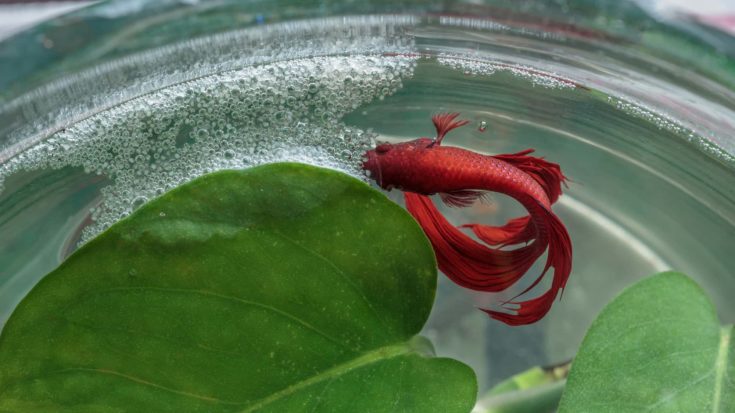
Within an hour or two, your male betta should get busy constructing his bubble nest. He’ll probably spend a lot of time darting between the nest and the divider/vase to show-off for your female betta.
It takes between 12 and 24-hours for the male to build his nest, so you may need to return your female to her tank in the meanwhile if you’re using a vase, since she can’t stay in such a small space for too long.
Depending on the size of the container, leave her with the male for two to four hours and then let her return to her own tank until the nest is ready. Don’t feed either fish until they’re finished mating, since it’s normal for them to fast during the courtship process.
4. Get Ready To Mate Your Bettas!
Once the nest is ready, it’s time to let the male and female bettas interact directly. If you’re using the vase method, return your female to the vase and allow her to acclimate for another 30 minutes.
Before removing the divider or releasing the female from the vase, check her receptivity to your male betta. Has her color deepened, and can you see her vertical barring pattern? Is she flirting with your male? If so you can move on to the next step!
If the answer is no, or if she’s displaying horizontal bars or keeping her fins clamped close to her body, then stop. She isn’t ready. You either need to start over with another conditioned female or give your current lady a couple more weeks of conditioning and try again. Do NOT proceed if your female is not receptive to your male betta!
5. Release Your Female Into The Breeding Tank And Cover With Plastic Wrap
Remove the divider or tilt the vase to release your female into the tank with your male betta.
She’ll probably swim straight to the bubble nest to check it out. If she’s not satisfied with the nest she may swim away, or she might destroy it. If she destroys the nest, you’ll need to remove her and try again the next day, but if she rejects the male’s nest a second time you should start over with a new pair of fish.
As soon as he sees her loose in his tank, your male will put on a first-class display and will start chasing her around the tank. Male bettas can be very aggressive with their advances, so keep an eye on things and remove the female immediately if you think she’s in any danger.
If things look like they’re going well, cover the open top of your tank with plastic wrap to increase the humidity inside, but keep an eye on things and be ready to intervene if your female is distressed.
If your female isn’t responding the way he’d like, the male may bite at her fins and chase her around. This is normal mating behavior, but if your female refuses to interact at all and hides from your male fish, she’s clearly not ready, so return her to her home tank and start over with a different female.
6. Breeding Your Bettas: Mating Dance And The Nuptial Embrace
Your bettas will chase, bite and swim together for a few hours as your female prepares to deposit her eggs in the bubble nest. At times, your female may rest in the Java Moss or behind the Moss Balls in the tank, so it’s important there’s plenty of hiding spots she can reach.
It can take from 2 to 12 hours for them to complete the mating dance and finish spawning. You’ll know things are heading on the right track when your fish swim next to each other and flare their fins every inch or so. As the mating dance progresses, the male betta attempts to flip the female upside down as he wraps himself around her, so he can fertilize the eggs as she releases them into the water.
This “nuptial embrace” lasts for a couple of minutes as your bettas float or even sink to the bottom of the tank together. Eventually, the male releases the female and they start in on another round. Your female will release a few eggs each time she’s “squeezed” in the male’s embrace. Female bettas often look listless or even close to death as they float on the surface and release their eggs, but they should quickly recover. Bettas usually lay 20 to 50 eggs per mating, but they can produce as many as 500, so it just depends.
Once your male stops trying to mate and starts collecting eggs and returning them to the bubble nest, it’s time to remove your female betta and put her back in her home tank. She’ll probably look quite ragged and may even have ripped or torn fins, so keep an eye on her and watch for signs of infection. Some breeders medicate their betta fish proactively after mating, but that’s stressful too and often unnecessary. Your female betta may be too tired to eat, so wait a day before offering her any food.
Leave the male betta in your breeding tank to care for the nest, and re-cover the tank with the plastic wrap to keep the humidity high, which helps the eggs develop. He’ll also cover the eggs with a cloudy milt to increase the odds of fertilization.
7. Watch The Male Care For The Embryos
It takes about 3 days for the fertilized eggs to develop into embryos and hatch. During that time, your male may build a new nest and move the eggs, or he may leave them where they are as he fusses over them.
It’s best to fast your male during this period, to reduce the chances that he’ll snack on the eggs. Most male bettas show little interest in food while they’re caring for their bubble nests, anyway, so there’s no reason to let food decay in the water, which could raise the toxin levels and hurt the fry.
Occasionally, a first-time father eats all of the eggs. If that happens, you’ll have to start over, but most male bettas figure things out by the second mating and don’t repeat the behavior. Don’t panic if you see your male eating an egg or two; they will naturally eat eggs that are unfertilized or not developing properly.
8. Hatching The Eggs
When the eggs reach the right stage of development they’ll hatch, usually about 3 to 4 days after they’re laid. You’ll still be able to see the yolk sac that’s been feeding the developing embryos since it won’t fully absorb into the fry’s abdomen for another 24 hours.
At this point, the fry usually hang near the surface of the water in the bubble nest with their tails pointing down, and they don’t move very much. Over the next 36 hours, the betta fry absorbs the oxygen in the bubble nest. As the nest collapses, they sink to the bottom and the male gathers them back up.
Within 3 to 4 days of hatching, the fry becomes free-swimming and it’s time to return your male betta to his home tank for some well-earned rest and recuperation. It takes 3 to 4 months to raise the juvenile bettas until they’re fully developed and ready for their new homes.
Conclusion
As you can see, it takes a lot of planning and preparation to breed bettas and they’re certainly more challenging than the live-bearing guppies, mollies and platys. Have you thought about or tried breeding bettas yourself? We’d love to see your thoughts, so drop a comment below or check us out on social media!
Want a unique name for your Betta fish? Find inspiration on our list here.
During my betta breeding, the female betta became more receptive to mating when a little brine shrimp was given initially. She definitely did not have as big of an appetite and the male was too busy building the nest to eat. However, the little bit of food seemed to signal to the female it’s a good spawning environment. She became more receptive and therefore the male stopped nipping at her as well.
Going to start as a hobbie to raise and breed the betta ,hope i can count on u for infor if needed .i liked the info.thanks